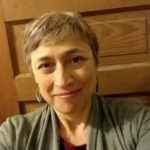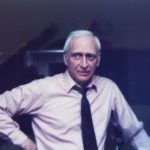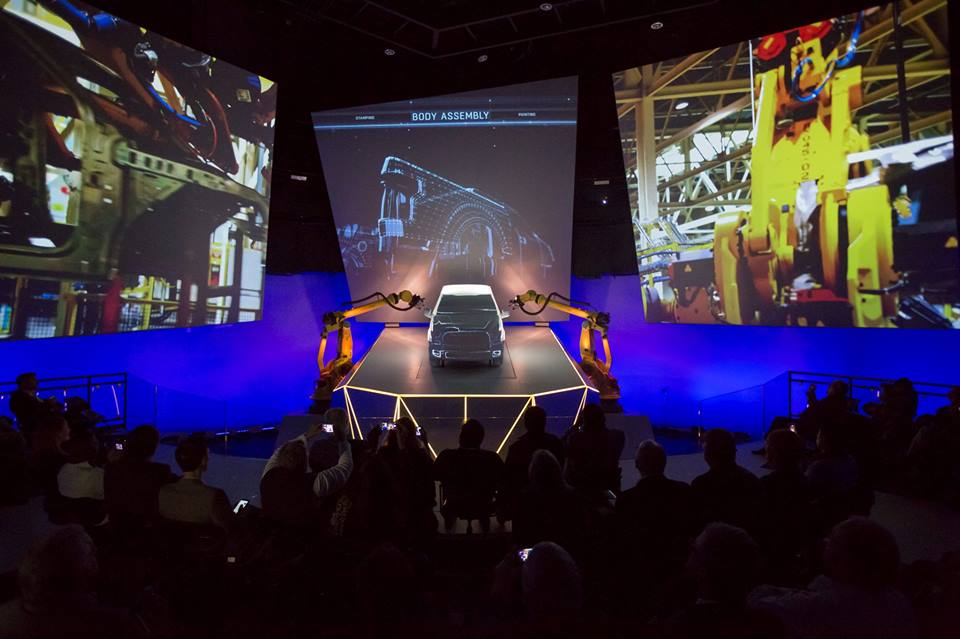Manufacturing Innovation introduces guests to the concept of a breakthrough car model
by Judith Rubin
This article is adapted from the original version published by Lighting&Sound America magazine, and is reprinted here with permission. Visit www.lightingandsoundamerica.com.
“The Ford Motor Company had just announced the new F-150 truck and we had an experience we needed to turn over in about nine months,” said John Neilson, senior director, museum and attractions, The Henry Ford Museum of American Innovation, at the 2016 Thea Awards in Anaheim. Manufacturing Innovation—which opened in February 2015 as the new key attraction of the Ford Rouge Factory Tour at The Henry Ford Museum in Dearborn, Michigan—was being honored by the Themed Entertainment Association for Outstanding Achievement.
The Ford Rouge Factory Tour is a joint partnership between The Henry Ford and Ford Motor Company. Visitors learn the history of the factory that engendered a long line of famous vehicles, and get to know the modern Rouge facility, where robots and people collaborate to turn out the breakthrough F-150 pickup, the star of Manufacturing Innovation. “This is the truck that is going to change the industry, and we needed to have a theater that would match,” says Cynthia Jones, general manager.
Manufacturing Innovation rehabbed a space originally created in 2004. Facing a warp-speed time line, Neilson, with colleagues Christian Overland (executive VP, The Henry Ford) and Jones, decided things would move most smoothly using BRC Imagination Arts, the same experience design agency that had done the earlier project. BRC’s revamp team was headed by Marci Carlin (executive producer) and Christian Lachel (creative director), who had both worked on the earlier version, and also included Edward Hodge (creative technical director), Philipp Edelmann (project manager), and Chris Pavlica (media director). Others on the external design and production team, brought in by BRC, were NYXdesign (lighting design), TechMD Inc. (AV and control systems), AES (fabrication), Gantom Lighting & Controls (lighting systems) and David Kneupper (composer).
Guest experience
Manufacturing Innovation is a two-theater experience. Each theater has 100 seats. The preshow in Theater 1 is a 12-minute, narrated documentary-style movie, on three screens, of Ford and auto manufacturing history through the years. The score was recorded by the Detroit Symphony Orchestra. It culminates with a message from Bill Ford Jr. (executive chairman, Ford Motor Co.), after which visitors are pulsed into Theater 2.
Ford’s F-150 pickup trucks are its top product line, and the nine-minute show in Theater 2 is a powerful showcase. It unfolds mostly sans spoken word, but begins, in slice-of-life style, with a company innovation rep asking various truck owners for input about the qualities of a dream pickup—for example, the aluminum body that is a hallmark of the new F-150. This transitions to scenes of the vehicle being designed and engineered, and then manufactured in the modernized factory. Next comes the signature sequence Lachel described as “3-D printing the car in the theater.” The prop truck rises up from the stage, the circular space comes alive all around the guests with multimedia effects and techno-style music, and the two industrial robots flanking the stage swing into action. The truck passes through the phases of manufacturing and assembly and then goes for a spin. The show ends with a bang and a flash, after which visitors are free to explore the rest of the Ford Rouge facility, which includes a real factory tour and a display of vintage automobiles, including the iconic Mustang and Thunderbird.
Theater 1 underwent some updates, primarily in terms of media editing, audio retrofitting, and updated, automatic control of visitor flow. But Theater 2 is where the big changes took place; its new show depends on a tightly integrated blend of custom media, projection mapping, music, lighting, special effects, moving set pieces, and choreographed industrial robots. Existing projectors and screens were kept, but reconfigured and updated with new equipment and control systems.
The design envisioned a physical rendition of gaming to connect viscerally with young audiences. “We wanted to meet the audience where they are at, so they’d feel ‘This is my generation’s story,’” Lachel says. “We did that with the media, using a visual language in the film to evoke the wire frames of gaming, and to speak to maker culture, 3-D printing, and coding.”
“The innovation, robotics, lighting, science, and technology of the truck and what’s happening at the plant became our design language for the show,” Lachel says. “Whether you build a show or build a vehicle, today we’re using the same technologies. It’s exciting for all of us—so much change, so much access to tools. It’s like being in Tony Stark’s Iron Man lab.”
Take the truck and stretch it into the room
As is usual in a 4-D theater, lighting design takes place in an environment where the chief element is video. Manny Treeson, of NYX Design, says, “The film is the principal form of storytelling, along with the projection-mapped truck. There was not a big need for lighting in the absolute sense, but it involved cars, robots, and big ideas. They were looking for ways for lighting to take the truck and stretch it into the room. We were to use light as part of that extended canvas that whips around the room and surrounds the audience. I tried to pull colors of the film into the theater, using one major color saturation tone and one highlight tone.”
Because the robots were constantly moving, it was decided to create attachment points enabling them to carry their own lights. “Due to the robots’ nature, there are lots of places you can bolt, and weight is not an issue,” Treeson says. “Each one of those lights is intelligent, and can articulate, so the light could grow in a sequence. We could use the lights to mimic the laser effects, and the flicker of blue-white welding and all those things robots do in manufacturing the vehicle.”Each robot arm ends in a claw, with three lights attached. These can read as a face—and, as such, are key to a final moment of the show, when, having finished “building” the truck, the robots turn these “faces” to the audience and seem to wink.
The Theater 2 lighting system was a complete retrofit using the existing grid from 2004, integrated with the existing ETC Paradigm system and adding an ETC Eos control console. “This allowed me to leave all the programming in place that already existed for the rest of the building,” Treeson says.
Once the illusory truck has progressed through stamping, welding, and painting stages all the way to quality control, it goes for a ride on-screen through a range of environments. “We had to help the theater take that journey with the truck,” Treeson says.
Robot breakthrough
BRC’s role as creative producer included, according to Hodge, master planning, design, writing, editing, media production, project management, overall creative direction, and close coordination with the architectural firm (Harley Ellis Devereaux) and general contractor (Baum Construction). The process began with a two-day charrette, and production kicked off about five months prior to opening. “Normally, it would be closer to a year,” says Hodge, “but we were able to compress it by having the idea very solid walking in, with storyboards and concepts, bringing in strong tech partners to help determine what could be done within time and budget, and treating the manufacturers like partners. For everything, we had to have a Plan B; there would be no time to scramble and design down the path.”
The robots, built by FANUC, were hard to get quickly. “Robots want a six-month delivery window,” said Hodge. “They are made to order, usually not in the US.” From a list of Ford factory-bound units, “we found the tallest, fastest robots with the largest arm reach we could fit in the building, and asked to have them diverted to us.”
The robots being huge, heavy, and potentially dangerous, audience safeguards include barriers, touch mats inside the barriers, motion detection, and 25,000 individual fault safes. A PLC computer backstage monitors all life safety systems and can override the show action.
Gear-agnostic
TechMD handled the retrofit of the audio and control systems, added projectors and players for projection-mapping the vehicle, and ensured that the original video system was brought up to current standards.
Dave Revel, president of TechMD, reports that, because media is playing a larger and larger role on projects, project heads are bringing AV integrators into the process sooner, as BRC did here. “Coming in early lets us lay groundwork, minimizes conflict with other disciplines, and ensures we will have the tools to do the job. There’s a place for our gear and it fits the big picture. These days, you’ve got to be talking about the tech and the content at the same time. We try to be gear-agnostic.”
BRC and Ford asked the team to re-use as much gear as possible. “It was a challenge to match up and document its condition, and, as it had been running several years, to make it work as a system with the new gear.” In both theaters, TechMD upgraded playback and control electronics, and added new audio playback, processing (QSC), and video servers (7th Sense).
Reusing the existing seven screens took some effort. “We spent two days swapping them around to change the focal point in the room,” Hodge says. “The GC were heroes—the screens couldn’t touch the ground in the course of moving them. It was a nail-biter.”
Of the dozen projectors in Theater 2, seven are existing, four-year-old Christies (DS+750), mounted around the room. Five new Panasonic (four PT-DZ87OULK units and one PT-DX100) are positioned in the truss work above the prop car.
The building’s existing cable infrastructure needed to support the new, higher-resolution video. “We had to test all cables to all projectors for their ability to pass increased bandwidth,” Revel says. Using new 7th Sense video servers with the older Christies presented its own challenge. The Christies have a 4 x 3 aspect ratio, while the newer projectors are 16 x 9 and 16 x 10. “We had to make sure that the pixels were square, not stretched or squashed,” Revel says. “Sometimes, projectors will try to fit an image in. It was a matter of cropping the image and then making sure the Christies didn’t try to do anything on their own—a case when a smart projector can be too smart. Christie helped us find the hidden menus.”
On the map
In its Burbank shop, TechMD mocked up the projection mapping at roughly 10%. “We mounted projectors in the scale model and were able to give a preview demo to BRC and Ford for approval,” Revel says. “By reducing throw distance in scale, you can make your projector behave down to about 1/8 scale and scale brightness, lensing, and image size.”
In charge of the building is an advanced Medialon show control program, customized by TechMD. “It constantly monitors the status of all systems, the position of the truck and doors, the robots, and all facility doors,” Hodge says. All theaters have custom touch panels employing what Hodge describes as a “really beautiful custom-designed user interface by us and TechMD.”
Amazing times
In the words of Christian Lachel, “We live in an amazing moment in history. What we’re doing in manufacturing and the way we tell stories is coming together.”
A viewer from The Detroit News called the theater experience a “wild ride” reminiscent of a Fast and Furious action film. Afterward, guests understand much better what goes into the conception and making of a Ford car and if Manufacturing Innovation has really done its job, feel a reinforced kinship with the brand. • • •

Author’s note: I was pleased to have the opportunity to write this story. As a public school student in Detroit in the 1960s, I went on school trips to Greenfield Village, an extensive campus of historical exhibits within the Henry Ford complex. Since then, I’ve had the opportunity to be impressed, as an adult, by what The Henry Ford offers. Readers might be surprised at the many authentic treasures of industry and history showcased across its 250 acres. A few: the bus on which Rosa Parks took her famous stand, workshops of

Thomas Edison and the Wright Brothers, and presidential limos from Teddy Roosevelt to Ronald Reagan (including JFK).
This article is dedicated to the memory of my late father, Irving Rubin, who spent most of his career as a Ford executive. Irv counted among his greatest achievements that he’d played a role in national seat belt legislation.






